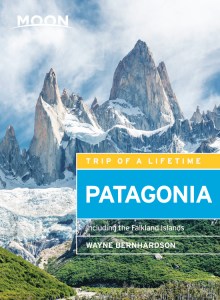La Cuarenta: Argentina’s Most Adventurous Road
From the Bolivian border near La Quiaca to its terminus near Río Gallegos, RN 40 has been Argentina’s great, unfinished interior highway. Some segments of “La Cuarenta” (cuarenta means “40”) in the central Cuyo provinces have long been smoothly paved, while others in the Andean northwest remain rough and rugged. None of those has enjoyed the notoriety of the segment between the El Calafate junction and the town of Perito Moreno, on the cusp between the Patagonian steppe and the icy southern Andes.
It’s no longer Argentina’s loneliest road—some of the cul-de-sac tracks that spin off it seem simply abandoned—but for Argentines and foreigners alike it’s been the standard for adventurous driving and cycling thanks to its secluded Andean lakes, isolated estancias (ranches), plentiful wildlife, and sights like the pre-Columbian rock art of Cueva de las Manos. Even the advent of ever more frequent public transportation has not diminished its mystique.
In recent years, the summer season has seen a growing procession of motorists, motorcyclists, and bicyclists (though most cyclists prefer the Chilean side). Some, at least, appreciate Charles Darwin’s insight that the appeal of the bleak Patagonian plains was “the free scope given to the imagination.”

A trip on La Cuarenta still requires preparation. With accommodations and supplies few and far between, bicyclists and motorcyclists must carry tents and cold-weather gear, even in midsummer, and plenty of food. A GPS and maps, like ACA’s newest regional sheets, are essential. Motorists might feel more comfortable with two spare tires. Also carry extra fuel—between El Calafate and Perito Moreno, the only reliable supplies are at El Chaltén (a 90-kilometer detour), Tres Lagos, Gobernador Gregores (which sometimes runs out), and Bajo Caracoles (which also sometimes runs out). Some tourist estancias will sell gasoline to their clients in an emergency, but don’t count on it.
Hazards remain. Powerful winds can knock cyclists down in an instant. Deep gravel adds to the danger in some spots. Even high-clearance vehicles are vulnerable to flipping on loose gravel, especially when braking suddenly. Though four-wheel drive is not essential, some drivers prefer it to avoid fishtailing on gravel.
Chipped, cracked, and even shattered windshields are par for the course. Normally, rental-car insurance policies do not cover such damage, and replacements are expensive in Argentina (though fairly cheap in Punta Arenas, Chile). Approaching vehicles usually brake to minimize the possibility of damage, but some drivers find they need to play chicken to slow down an onrushing pickup truck or SUV.
About half of this segment of RN 40 is paved and the rest of it seems likely to be completed within a few years. Because of rerouting, it now passes through Gobernador Gregores (anyone nostalgic for the old route can still take on the graveled shortcut of RP 29).
If driving or cycling doesn’t appeal to you, but you still want to see the “loneliest highway,” summer bus and minivan services now connect El Calafate and El Chaltén, at the south end, with Perito Moreno and Los Antiguos at the north end of Santa Cruz province, and with Bariloche.
